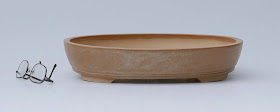Growing moss seems to be one of the supporting tasks a lot of bonsai enthusiasts take on. When you need it, it can be hard to find, so often better to grow your own. I have a number of seed propagation trays filled with a gritty heavy mix which I normally use and the moss grows well as long as it has plenty of water and strong light.
As an experiment at the start of the summer months ago I pulled up a few pads of moss growing on the tops of some of my bonsai pots. I put these onto a glazed ceramic tile and placed the tile on one of my bonsai benches. The moss received many hours of direct sunlight every day and was exposed to the same watering as my trees - which has been twice a day in the heat of summer. Suffice to say the moss has thrived.



















